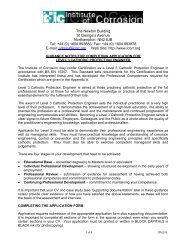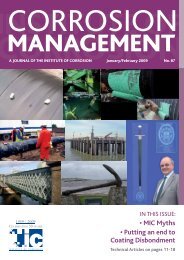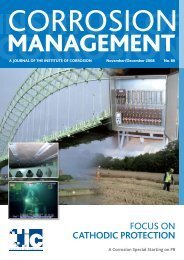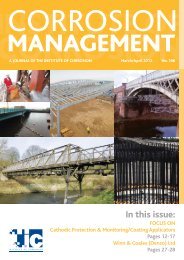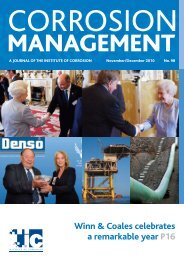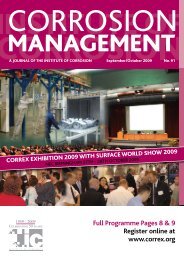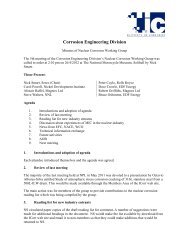In this issue: - the Institute of Corrosion
In this issue: - the Institute of Corrosion
In this issue: - the Institute of Corrosion
You also want an ePaper? Increase the reach of your titles
YUMPU automatically turns print PDFs into web optimized ePapers that Google loves.
<strong>Corrosion</strong>Management | July/August 2011<br />
TECHNICALARTICLE<br />
Hardness – The presence <strong>of</strong> <strong>the</strong> cobalt chromium<br />
carbide coating on <strong>the</strong> titanium alloy increased<br />
<strong>the</strong> surface microhardness from 330 HV to over<br />
400 HV as deposited. Pure chromium carbide,<br />
known to be very hard with 1200 VHN (Vickers<br />
hardness number) contributed to <strong>the</strong> increase <strong>of</strong><br />
<strong>the</strong> hardness. The carbide particles in <strong>the</strong> metal<br />
matrix serve as <strong>the</strong> aggregates contributing to<br />
<strong>the</strong> higher hardness whereas <strong>the</strong> metal matrix<br />
functions like a carrier for <strong>the</strong> hard aggregates.<br />
The higher concentration <strong>of</strong> <strong>the</strong> chromium<br />
carbide content in <strong>the</strong> deposit <strong>the</strong> harder <strong>the</strong><br />
deposit should be. However, <strong>this</strong> trend did not<br />
always appear in <strong>the</strong> brush-plated deposits. The<br />
size <strong>of</strong> <strong>the</strong> carbide particle may have had a role<br />
in contributing to <strong>the</strong> hardness.<br />
The <strong>the</strong>rmal stability <strong>of</strong> <strong>the</strong> Co-Cr 3<br />
C 2<br />
composite<br />
was tested by heat treatments at a series <strong>of</strong><br />
temperatures up to 815° C, Table 2. Hardness<br />
measurements indicated <strong>the</strong> Co-Cr 3<br />
C 2<br />
composite was <strong>the</strong>rmally stable. Typically after<br />
heating a pure metal to an elevated temperature<br />
<strong>the</strong> hardness <strong>of</strong> <strong>the</strong> metal decreases. The<br />
hardness <strong>of</strong> <strong>the</strong> composite did not decrease<br />
after heating to elevated temperatures, in fact a<br />
somewhat higher hardness was measured after<br />
heat treatment.<br />
Taber wear index data <strong>of</strong> MMC Co-Cr 3<br />
C 2<br />
coated<br />
and uncoated Ti-6Al-4V panels is presented in<br />
Figure 7. The MMC Co-Cr 3<br />
C 2<br />
coated material has<br />
a significantly lower wear rate than uncoated<br />
Ti-6Al-4V. The decrease in wear index as <strong>the</strong><br />
number <strong>of</strong> cycles increases is believed to be due<br />
to a decreasing in roughness <strong>of</strong> <strong>the</strong> coating. The<br />
roughness <strong>of</strong> <strong>the</strong> as-plated deposit is decreased<br />
by <strong>the</strong> abrasive action <strong>of</strong> <strong>the</strong> CS-17 wheels. A<br />
smoo<strong>the</strong>r surface has a lower wear rate.<br />
The Taber wear index for a cobalt metal coated<br />
panel is compared to a MMC Co-Cr 3<br />
C 2<br />
coating<br />
in Figure 8. The wear index <strong>of</strong> <strong>the</strong> composite<br />
Table 2. Hardness (VHN) <strong>of</strong> Co-Cr 3<br />
C 2<br />
deposit after 1 hour heat treatment.<br />
Cr 3<br />
C 2<br />
wt% As deposited Heat Treatment Temperature<br />
400° C 750° C 815° C<br />
12 - 15 442 505 498 485<br />
25 - 30 418 485 476 482<br />
Figure 7. Taber wear index measured for MMC<br />
Co-Cr 3<br />
C 2<br />
and Ti-6Al-4V.<br />
Figure 9. Taber wear index for MMC Co-Cr 3<br />
C 2<br />
and Ti-6Al-4V after exposure to 400°C.<br />
composite coating. The Ti-6Al-4V wear index<br />
is not changed by exposure to <strong>this</strong> elevated<br />
temperature.<br />
Residual Stress – Residual stress is an important<br />
factor involved in reliability <strong>of</strong> high temperature<br />
coatings. It may influence some key<br />
performances <strong>of</strong> coatings such as <strong>the</strong> resistance<br />
to spalling, delamination, and surface cracking.<br />
The residual stress <strong>of</strong> MMC Co-Cr 3<br />
C 2<br />
on titanium<br />
6Al-4V alloy measured by x-ray diffraction is<br />
presented in Table 3. The residual stresses were<br />
tensile. The residual stress <strong>of</strong> Co-Cr 3<br />
C 2<br />
coating<br />
was less than that <strong>of</strong> plated Co metal. The high<br />
residual stress appears to be due to <strong>the</strong> cobalt<br />
metal and not <strong>the</strong> chromium carbide or its<br />
combination with <strong>the</strong> cobalt metal matrix.<br />
Coating<br />
Stress, kpsi<br />
Co–Cr 3<br />
C 2<br />
31 ± 3<br />
Normally a metal coating is oxidized upon<br />
exposure to high temperatures. The MMC Co-<br />
Cr 3<br />
C 2<br />
coating exhibited a strong oxidation<br />
resistance at high temperatures. The MMC<br />
Co-Cr 3<br />
C 2<br />
plated parts after exposure to 800°C<br />
for 30 hours did not show any sign <strong>of</strong> being<br />
oxidized. A Ti-6Al-4V panel showed yellow dust<br />
indicating some extent <strong>of</strong> oxidation occurred<br />
after 1 hour at 800°C. <strong>In</strong>terestingly, a steel<br />
panel was severely oxidized after exposure to<br />
800°C for one hour.<br />
Taber Wear <strong>In</strong>dex – The Taber wear tests were<br />
performed following ASTM Test Method D 4060-<br />
95. The wear index (μg/cycle) is calculated as<br />
follows:<br />
(A – B) 1000<br />
Wear index =<br />
C<br />
where A is <strong>the</strong> weight <strong>of</strong> test specimen before<br />
abrasion, mg, B is <strong>the</strong> weight <strong>of</strong> <strong>the</strong> test specimen<br />
after abrasion, mg, and C is <strong>the</strong> number <strong>of</strong><br />
cycles. A 1000 g load was applied to <strong>the</strong> CS-17<br />
abrasive wheel.<br />
Figure 8. Taber wear index measured for MMC<br />
Co-Cr 3<br />
C 2<br />
coating and metal Co coating.<br />
coating was significantly lower than that <strong>of</strong><br />
plated cobalt metal.<br />
Exposure to an elevated temperature <strong>of</strong><br />
400°C leads to a decrease in wear index <strong>of</strong><br />
<strong>the</strong> composite coating, Figure 9. This data<br />
fur<strong>the</strong>r confirms <strong>the</strong> good high temperature<br />
performance <strong>of</strong> <strong>the</strong> brush plated Co–Cr 3<br />
C 2<br />
Co 33 ± 3<br />
Table 3. Residual stress <strong>of</strong> Co-Cr 3<br />
C 2<br />
and Co<br />
coatings on Ti-6Al-4V alloy determined by<br />
XRD.<br />
Key Characteristics – Table 4 summarizes<br />
<strong>the</strong> surface characteristics <strong>of</strong> <strong>the</strong> cobaltchromium<br />
carbide brush plated composite.<br />
The key characteristics <strong>of</strong> Ti-6Al-4V alloy were<br />
improved by a brush plated MMC coating. The<br />
MMC improvements are more significant than<br />
those <strong>of</strong> a Co metal plated coating especially<br />
after exposure to high temperatures. The<br />
improved surface characteristics should lead to<br />
increased resistance to fretting, adhesive wear,<br />
and abrasive wear.<br />
Future Work<br />
Future work should investigate <strong>the</strong> cause <strong>of</strong> <strong>the</strong><br />
high residual stress. The chemistry <strong>of</strong> <strong>the</strong> cobalt<br />
plating solution and <strong>the</strong> deposition parameters<br />
should be examined for <strong>the</strong>ir contribution to<br />
internal stress.<br />
10



